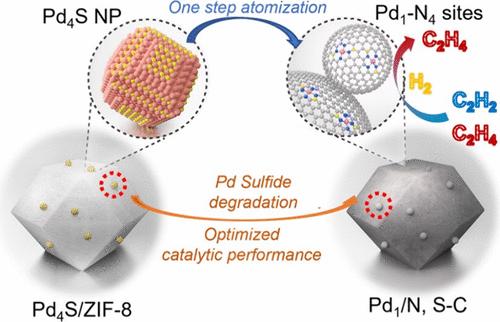Recycling Sulfur-Poisoned Pd Catalysts via Thermal Atomization for Semi-Hydrogenation of Acetylene
IF 14.4
1区 化学
Q1 CHEMISTRY, MULTIDISCIPLINARY
引用次数: 0
Abstract
Palladium catalysts are highly efficient for a variety of chemical industrial processes but are prone to being affected by poisons during practical application. Sulfur is one of the major poisons in Pd-based catalysts. The recycling of deeply poisoned Pd species like Pd sulfides is challenging due to the strong Pd–S bond. Herein, we proposed a top-down strategy to degrade Pd sulfides and create Pd single-atom sites simultaneously by one-step thermal atomization. Pd4S model nanoparticles were successfully converted to Pd single-atom sites supported on nitrogen and sulfur-codoped carbon (Pd1/N, S–C) after loading them on ZIF-8 and thermal treatment. PdZn intermediates were formed during the atomization process. Density functional theory revealed that the formation of PdZn helped the generation of vacancies adjacent to metal nanoparticles, which prompted the atomization process. This strategy can be facilely applied to the atomization of sulfur-poisoned commercial Pd/C, which shows the potential for recycling commercial catalysts. The optimal Pd1/N, S–C catalyst showed good activity and much enhanced selectivity than Pd4S for the semi-hydrogenation of acetylene.

通过热雾化回收硫中毒钯催化剂用于乙炔的半加氢反应
钯催化剂在各种化学工业过程中具有很高的效率,但在实际应用过程中容易受到毒物的影响。硫是钯基催化剂中的主要毒物之一。由于 Pd-S 键很强,回收像 Pd 硫化物这样的深度中毒 Pd 物种具有挑战性。在此,我们提出了一种自上而下的策略,通过一步热原子化同时降解钯硫化物和创建钯单原子位点。将 Pd4S 模型纳米粒子装载到 ZIF-8 上并进行热处理后,成功地将其转化为支撑在氮和硫掺杂碳(Pd1/N, S-C)上的 Pd 单原子位点。雾化过程中形成了 PdZn 中间体。密度泛函理论表明,PdZn 的形成有助于在金属纳米粒子附近产生空位,从而促进雾化过程。这一策略可方便地应用于硫中毒的商用 Pd/C 的雾化,显示了商用催化剂回收利用的潜力。最佳的 Pd1/N、S-C 催化剂在乙炔的半加氢反应中表现出良好的活性,选择性也比 Pd4S 强得多。
本文章由计算机程序翻译,如有差异,请以英文原文为准。
求助全文
约1分钟内获得全文
求助全文
来源期刊
CiteScore
24.40
自引率
6.00%
发文量
2398
审稿时长
1.6 months
期刊介绍:
The flagship journal of the American Chemical Society, known as the Journal of the American Chemical Society (JACS), has been a prestigious publication since its establishment in 1879. It holds a preeminent position in the field of chemistry and related interdisciplinary sciences. JACS is committed to disseminating cutting-edge research papers, covering a wide range of topics, and encompasses approximately 19,000 pages of Articles, Communications, and Perspectives annually. With a weekly publication frequency, JACS plays a vital role in advancing the field of chemistry by providing essential research.

 求助内容:
求助内容: 应助结果提醒方式:
应助结果提醒方式:


